FREE Standard Shipping On All Orders $100 or More!*
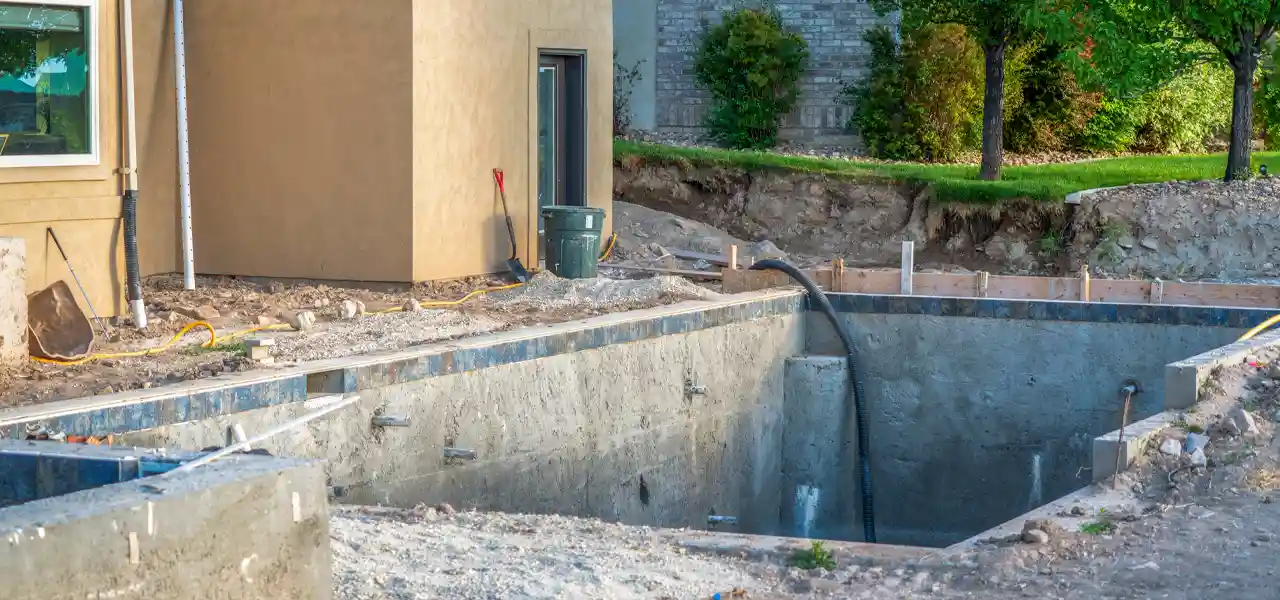
Inground Pool Construction and Groundwater Issues
It only happens rarely, but sometimes when digging inground swimming pools you may discover a high water table. Or, there can be issues with surface ground water, flowing towards your future pool. Don't let this scare you, there are solutions for these that you can take care of yourself.
Dealing with Surface Run-Off Around Your Inground Pool:
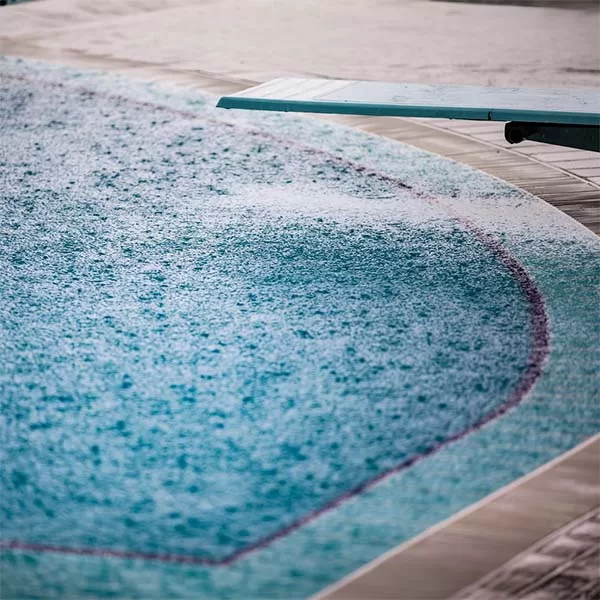
If your pool area is lower than the ground around it you will need to provide a route for the water to go around, not into or under, your swimming pool. Small retaining walls with french drains can be installed, or you can dig a 18" deep trench next to the pool deck and cover with a few inches of 3/4 in. stone. Top this with a perforated drain pipe and then another layer of stone, before backfilling the trench, slightly lower than the surrounding ground. Now, when the water flows towards your pool, it will hit your drainage area and flow around to the lower end of the pool.
Another way to combat surface runoff water is to cut a swale into the ground before your pool patio. What this is would be a V shape cut in the ground with a pitch away to one end of the pool. The water would hit this and flow down and out the pitched end.
Dealing with High Water Table Around Your Inground Pool:
Water issues from a high water table, encountered during excavation, is the main topic of this blog post. It usually happens while digging an 8' deep pool, and at 6 or 7 feet - you hit water. Usually you can pump it out and it doesn't come back, but sometimes the water seems to come back in as quickly as you can pump it out. (Make sure that while pumping out this water that you pump at least 50' away from the pool, to prevent "recycling" of the water back underneath the pool.)
De-watering solutions:
If the water keeps coming in, even though the weather has been reasonably dry, here's what you do. Keep digging! Over dig your deep end about 2 feet deeper than the pool depth. A trench should be dug, from the deep end floor, up the slope to the shallow end - also 2 feet lower. Then have your gravel delivery company bring you enough 3/4" stone to fill in your over dug areas to within 2" from your finished floor level. If the soil is very sandy and loamy you will need more gravel than if you have a tight clay soil, to keep the water flowing.
After the gravel is in place, we will use 1.5" flexible PVC pipe to create a conduit for the water, while you continue to build your own inground pool. On the pool-end of the pipe, attach a check valve and a grate and run the pipe from the lowest part of the pool, out the bottom side of the pool, into the trench. Dig a trench outside of the pool, to the depth of the over dig. The trench will rise in level to about 1 foot below the ground. Continue to run the pipe to an area where you can connect it to a self-priming pump like an inground pool pump. Connect another pipe or hose on the discharge side of the pump, prime it up and turn it on. Shortly, the pump will start pulling your underground water out of the hole.
How to Test for High Water Table:
I'll admit it, there are some locations that make it difficult to build an inground pool. Low, topographically depressed areas, or shoreline areas that are actually below sea level. In severe cases, those who really want an inground pool can truck in enough fill dirt to raise the pool area up a few feet, so that ever-present ground water won't be an issue. In most cases, however, the dewatering approaches described here will solve the problem.
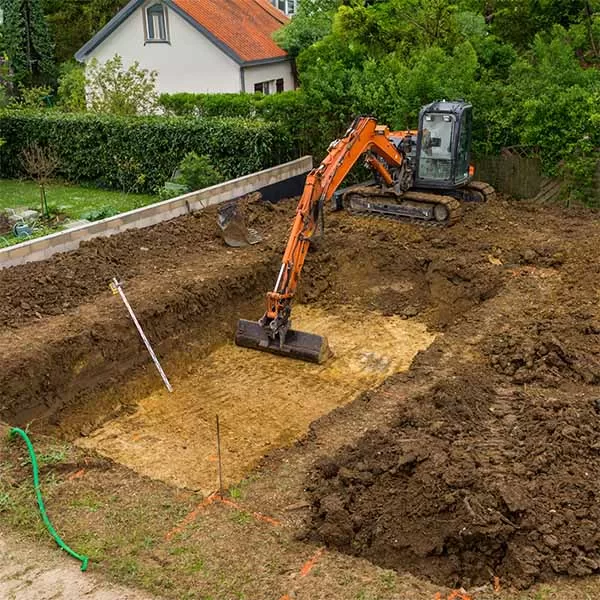
One way to test your ground water level is to use an auger drill to drill down to the level of your pool's deep end in several spots around the proposed pool site. Do this when the soil has a relatively normal water content - that is, not after a 3-day rain. Instead of the auger, you can dig a 4' deep hole large enough to stand in, and then use a post hole digger to dig down further to check for water. You may encounter some water at this depth, but it doesn't mean that your inground pool project is going to be difficult or impossible to construct!
A much less common occurrence is to hit ground water while digging the deep end. This can happen if your pool location is in a low depression as compared to the surrounding land, or if located beneath a hillside of any size. It can also happen after heavy rainstorms raise the water table.
In most cases, the water will subside...
My first advice is to just see if the water will recede back into the earth in a day or two, and then you can proceed with installing the pool floor, the liner, and adding water to fill the pool.
In some cases, the water won't subside...
If it keeps raining, or if the pool deep end is located within the water table. Start with a small submersible pump, and connect 100' of garden hose to run the hose away from the deep end as far as possible. Plug in the pump, and pump out the water in the deep end.
Inground Vinyl Pool Dewatering Methods
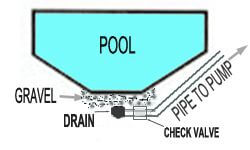
If precious days are passing during your inground pool construction, and weepers and leakers are continuing to fill the deep end area faster than you can pump it out, here's what you do. Get on the phone, or online and place an order for 2-3 yards of the cheapest gravel, usually #57 bluestone. Jump back in the track hoe, or just start hand digging, and overdig the deep end hopper by 2'. So, if you have an 8' deep end, overdig it to 10', and then dig a narrow trench from the now deeper deep end floor, up the side wall, and out of the pool, just underneath the pool wall.
Option one:
Place a main drain pot in the lowest spot of the floor, and connect a one way check valve with a short piece of PVC pipe. Then glue on a long section of flexible pipe that comes up to ground level. There you can connect your pool filter pump, with a male adapter. Fill the pipe and pump with water, and use it to dewater underneath the pool, until you get it full of water.
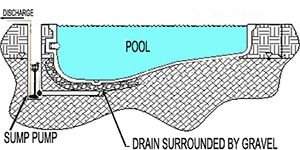
Option two:
Buy a cheap submersible pump with a long cord and place it in the lowest part of the overdug deep end. Cover with a few feet of gravel and run the discharge (garden) hose and the power cord up the sidewall trench and underneath the pool wall. The pump is abandoned underneath the pool after the pool is filled with water. It could be left in place, for pools with high water tables, but the motor will likely fail within a few years.
Option three:
For a more permanent solution, for pools that are very close and level with large bodies of water, or located in a flood plain. Place a main drain pot in the deepest part of the overdig, and connect a pipe that drains to a sump pump well, or a plastic vertical cylinder that is accessed at ground level. Inside the well, an automatic sump pump is placed, which will turn on when water in the well cylinder raises the float sensor.
Option Four:
Raise the pool! That is, bring in enough dirt, probably 20 yds or more of fill dirt, and raise up the earth in the pool and around the pool. This can only be done if you haven't already poured the concrete collar around the pool walls. This is a good solution for inground pool installations where you know water will be encountered; pools on a shoreline, in a floodplain, high water table, or for a location that receives a lot of storm water run-off. Steps can lead up to the pool deck, which can be 1-4 feet above the surrounding area.
Temporary or Permanent Pool Dewatering?
After the pool is filled with water on top of your 2" floor base material, that's heavy enough to keep water back, and your dewatering solution, so useful during construction, will no longer be needed, and the pipe or hose is left buried underneath the pool.
In a few cases however, a liner can 'float', when water gets underneath the liner, and causes a large visible bulge, usually after periods of very heavy rain. If you think that this may be a possibility, due to a poor pool location, high water table, excessive water runoff or bad soil types...you may want to have the ability to dewater underneath the liner, should your liner ever 'bulge'. Options 1 and 3 above are better to use for a permanent pool dewatering solution, but can be installed after a pool is already built, if needed.
Drainage:
Another thing to take into consideration is ground water or storm run off. You want your pool elevation to be at least 6" higher than the surrounding ground. Your entire construction area should be pitched away from the pool to allow good flow around the pool. This will allow water to run away form the pool and not towards it. If you have a hill behind one side of your pool you will want to cut in a swale and grade the land to divert the water around your pool.
Soil:
Different soil conditions play a role in pool construction water problems. Clay holds water and is always wet, where other loamy soils or sandy soils tend to drain better.
Topography:
The water table tends to follow the curve of the terrain. If your property is located in a very low, depressed area, topographically speaking, it will tend to have water table closer to the surface. The same may be said for pool locations that are very close to sea level elevation.
Rocks:
Large rocks that have to be removed are another problem. The biggest problem is having a machine big enough to remove the rock or bust up a stone ledge in the pool area. Boulders that are larger than the bucket can be strap lifted - but if they are too large, they may need to be broken first, which may require a jackhammer attachment.
After a very large boulder has been removed, clean fill dirt should be put in its place and compacted or tamped to bring the floor or walls back up to where they need to be. This can be a lot of work, so another option is to "shave" off large boulders. I have had rocks that were so big, when I only needed to dig another few inches, and it was easier to jack hammer the rock, or "shave it" than to remove the entire rock, and then backfill the crater.
Roots:
Large roots are another issue you may have with inground pool construction. You want to remove them for sure; but better if you can see where they are coming from and cut them back a good 10 ft or so from your pool area. Cut the roots within the excavation area only, and you are leaving yourself wide open for them to grow back within a few years, and damage the pool.
Large trees, and their roots can cause more problems later on - to your pool walls, floors, liner and surrounding pool deck. Plus, do you really want to be cleaning leaves out of the pool?
Most excavators will slice through large roots with ease, so that's not the real problem. The real problem are large roots that are cut off just a few feet from the pool walls and floors. Better to take out the tree, and poison the roots, or cut the roots back at least 10 feet from the pool walls.
How Can You Tell What's Underground?
There are no apps or divining rods to help you know if there is underground water or large rocks in your yard. You can do a little investigation on your own, however. Do any of your neighbors have an inground pool? Ask what they encountered underground, did they hit water or rock? Do you have a sump pump in a pit in your house, or basement water problems? You may already know if you have a high water table. Also consider the topography and drainage of the planned pool area.
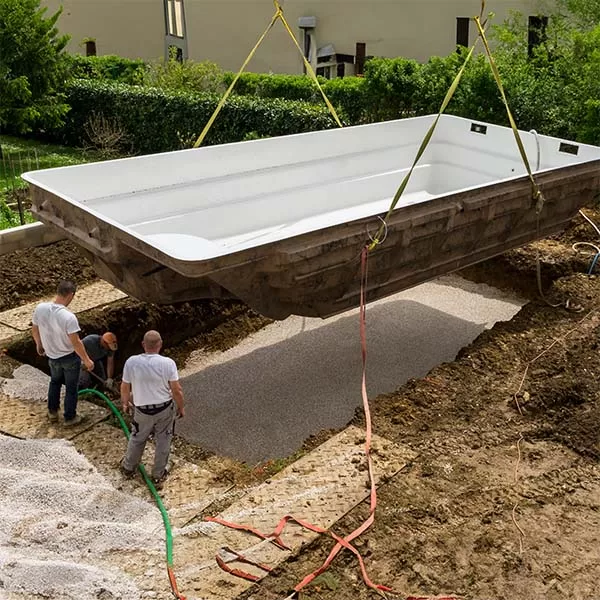
Your local building department may have an area map that shows water elevations, or the building inspector should have an idea of what's generally expected to be underground in your area. You could hire a company that uses GPR or ground penetrating radar, but that could be costly.
And of course, if you run into any of these problems with an In The Swim Pool Kit, we are here to help you every step of the way, like we were with Lloyd Brown's water problem during his very rainy pool construction week.
Remember that usually - there is nothing underground but tierra firma, with small rocks and surface roots. Large scale inground pool construction problems with rocks, roots and water are rare, and most situations are solved quickly and cheaply.
If you encounter water when you dig, do not worry - the In The Swim experts are here to help you with advice tailored to your situation. I've been involved in nearly 1000 pool builds, and we hit water about 10% of the time, but a true pool dewatering system is needed only less than 5% of the time.
One last piece of advice...
Pay attention to the long range weather forecast before you begin construction. If you have some flexibility in your schedule, you may avoid hitting water if you dig your pool during dry periods of the year, and when the 10 day forecast looks mostly sunny. If you can get a week of fairly dry weather, you will have less chance of hitting water.